Related Research Articles

Anjolie Ela Menon is one of India's leading contemporary artists. Her paintings are in several major collections, including the NGMA, the Chandigarh Museum and the Peabody Essex Museum. In 2006, her triptych work "Yatra" was acquired by the Asian Art Museum of San Francisco, California. Other works also been a part of group exhibitions including 'Kalpana: Figurative Art in India', presented by the Indian Council for Cultural Relations (ICCR) in London's Aicon Gallery in 2009. Her preferred medium is oil on masonite, though she has also worked in other media, including Murano glass, computer graphics and water colour. She is a well known muralist. She was awarded the Padma Shree in 2000. She lives and works in New Delhi.
Paresh Maity is an Indian painter. He is a prolific painter in a short career span. In 2014, Government of India conferred upon him its fourth-highest civilian award the Padma Shri.

Dhruva Mistry is an Indian sculptor.

Akbar Padamsee was an Indian artist and painter, considered one of the pioneers in modern Indian painting along with S.H. Raza, F.N. Souza and M.F. Husain. Over the years he also worked with various mediums from oil painting, plastic emulsion, water colour, sculpture, printmaking, to computer graphics, and photography. In addition, he worked as a film maker, sculptor, photographer, engraver, and lithographer. Today his paintings are among the most valued by modern Indian artists. His painting Reclining Nude was sold for US$1,426,500 at Sotheby's in New York on 25 March 2011.
Prayag Jha Chillar, also known as Prayag Jha, is a contemporary Indian artist who specializes in etching. Her works are kept in collections all over India, including the National Gallery of Modern Art in the capital, New Delhi. Jha's work has been showcased in solo exhibitions from 1971 to 2012 across Jehangir Art Gallery, Taj Art Gallery, Bajaj Art Gallery, and Art Heritage New Delhi. Her work depicts scenes from the ancient Indian epic Meghdoot and is inspired by natural forms, such as grass and leaves. Jha's earlier works were primarily monochrome, but have evolved to include strong colors.

Murlidhar Ramachandra Acharekar (1907–1979) was an Indian artist and film art director in Hindi cinema who won the Filmfare Best Art Direction Award three times: for Pardesi (1958), for Kaagaz Ke Phool (1960), and for Jis Desh Men Ganga Behti Hai (1962).
Pakala Tirumal Reddy (1915–1996) was an Indian artist. He was the fifth child born to Ram Reddy and Ramanamma at Annaram village, Karimnagar district, Telangana, India. He received his diploma in painting from J. J. School of Art, Bombay in 1939. He married Yashoda Reddy on 9 May 1947, and she completed a master's of art and Ph.D. degrees and authored over 22 compilations and novels.
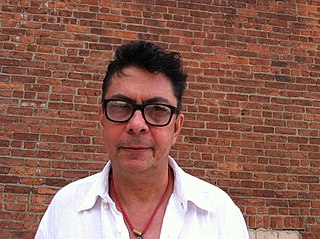
Chittrovanu Mazumdar is a contemporary Indian artist of Bengali-Indian and French descent. Mazumdar has been described as a "conceptual artist" and a "post-structuralist" while some critics consider it difficult to classify his oeuvre into a single artistic tradition or even into any consistent genre of his own. Mazudmar has referred to himself as an "expressionist painter" but has also said he generally prefers not to use "a particular word to qualify" his work because it comprises different kinds of media and forms, and that art is more interesting when fully given over to the viewer's own experience rather than constrained by the prescriptive power of labels.

Byomakesh Mohanty was an Indian artist and academic. After completing his science studies and graduating from Utkal University, Bhubaneswar, Orissa, he joined as a faculty of visual arts at Banaras Hindu University.

Riyas Komu is an Indian multimedia artist and curator based in Mumbai. He has invested his time in art education and developing art infrastructure in India. Komu's works are inspired by social conflicts and political movements and topics like migration and displacement. His hyper-realistic oil portraits of people resemble socialist-realist propaganda art, with one of his portraits titled Why Everybody should Look Like Mao.

Raman Siva Kumar, known as R. Siva Kumar, is an Indian contemporary art historian, art critic, and curator. His major research has been in the area of early Indian modernism with special focus on the Santiniketan School. He has written several important books, lectured widely on modern Indian art and contributed articles to prestigious international projects such as the Art Journal, Grove Art Online or The Dictionary of Art, Oxford University Press.

Biman Bihari Das is an Indian sculptor and former Principal of the Government College of Art & Craft, Kolkata. He was honoured by the Government of India, in 2014, by bestowing on him the Padma Shri, the fourth highest civilian award, for his services to the field of Fine Arts.
Chintan Upadhyay (born 1972) is an Indian visual artist, and convicted murderer. He began his art career as a painter, but later created sculptures and installations. His best known sculpture project is perhaps the Pet Shop project, which is an ongoing production of a "model baby" for every season, Baby Fetish.
Manu Parekh is an Indian painter, known for his several paintings on the city of Varanasi. Reported to be influenced by Rabindranath Tagore and Ram Kinker Baij, Parekh is a recipient of the 1982 Lalit Kala Akademi Award. The Government of India awarded him the fourth highest civilian award of the Padma Shri, in 1991.
Owais Husain is an Indian multi-media artist, painter and filmmaker.
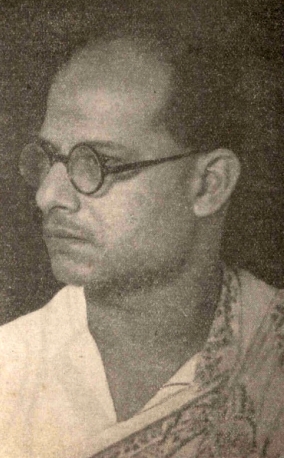
Devi Prasad Roy Choudhury was an Indian sculptor, painter and educator. He is well known for his monumental bronze sculptures, especially the Triumph of Labour and the Martyrs' Memorial, and is rated by many as one among the major artists of Indian modern art. He worked in a broad spectrum of mediums including watercolors, expressionist landscapes and commissioned portraits. Large scale sculptures were his particular strength and he made social realism the cornerstone of his art. In addition to painting and sculpting, he also wrestled, played the flute, engaged in hunting and wrote short stories in his spare time.

Arpana Caur is an Indian contemporary painter and graphic artist. Arpana Caur exhibits dynamism and deep insight in her depictions of women's conditions in modern India. A self-taught artist, Caur's portrayals of women in urban environments reflect her concerns with the issues of our time: life and death, violence, the environment, and women's issues. Clothing is a recurring theme in her work, both reinforcing and undermining the established image of women.
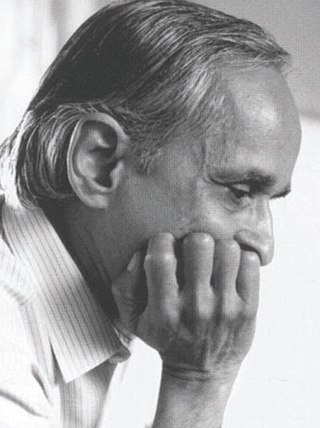
Prabhakar Barwe was a pioneer of Modern Indian painting. He was active in Mumbai, India from the 1959 until his death in 1995. Influenced by the esoteric tradition of Tantric painting, Barwe along with G. R. Santosh, P. T. Reddy, K.C.S. Paniker, Biren De, Om Prakash, K. V. Haridasan, Prafulla Mohanti and Mahirwan Mamtani was considered part of the modernist movement Neo-Tantra.
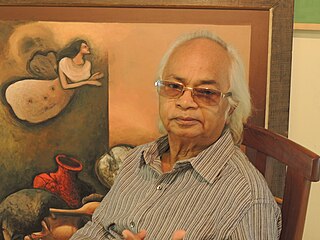
Jagadish Chandra Dey, also known as Jagdish Dey, is an Indian painter and printmaker, known for his unique style of surrealism, where the real and unreal coexist. He has been a member of many art societies and juries.
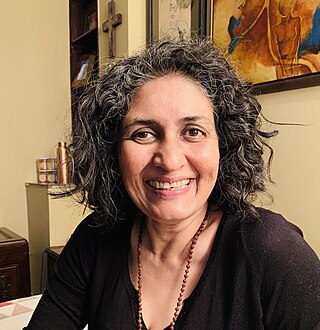
Seema Kohli is an Indian contemporary artist, sculptor and poet. She has worked across painting, sculpture and installation.
References
- ↑ "Jayasri Burman - Artists - Aicon Gallery".
- ↑ "The Telegraph She Awards 2021 saw women achievers being feted". www.telegraphindia.com. Retrieved 23 March 2021.
- ↑ "The Burman-Maity family is proof that creativity runs in the genes". Elle India. Retrieved 23 March 2021.
- ↑ "Artist Jayasri Burman paints the 'resilient' Ganga". The Indian Express. 18 December 2021. Retrieved 14 September 2023.
- ↑ "River of Faith: Jayasri Burman". India Art Fair. Retrieved 14 September 2023.
- ↑ Nair, Uma. "Jayasri Burman's sculptures revere River Ganga". The Times of India. ISSN 0971-8257 . Retrieved 14 September 2023.
- ↑ "Ganga remains our closest connection to the primordial power: Jayasri Burman". www.telegraphindia.com. Retrieved 14 September 2023.
- ↑ Nair, Uma. "Jayasri Burman's Gangetic lifescapes at Bikaner House". The Times of India. ISSN 0971-8257 . Retrieved 14 September 2023.
- ↑ "Jayasri Burman | Born of Fire: A Tale for Our Times - Exhibitions - Aicon Gallery". www.aicongallery.com. Retrieved 14 September 2023.
- ↑ "The Sunday Tribune - Spectrum". m.tribuneindia.com. Retrieved 14 September 2023.
- ↑ "Jayasri Burman". Saffronart. Retrieved 12 March 2019.
- ↑ "Jayasri Burman - Recognition". jayasriburman.com. Archived from the original on 17 January 2016. Retrieved 12 March 2019.
Art Alive Galery Listed Jayasri Burman